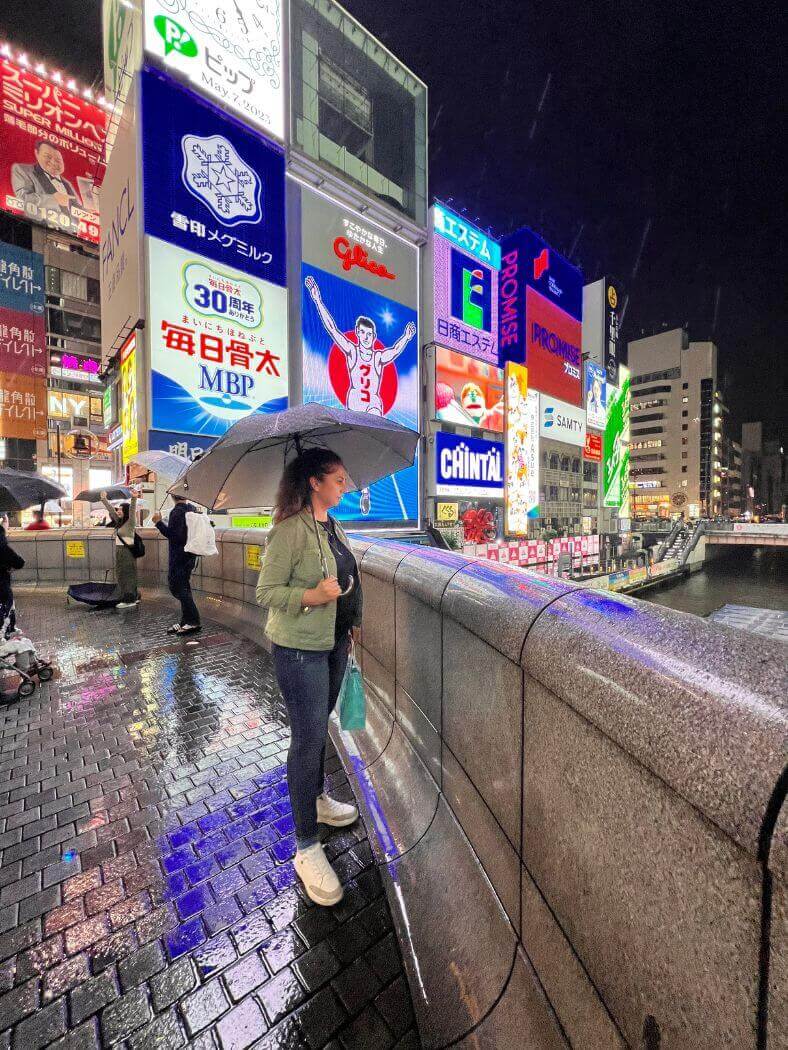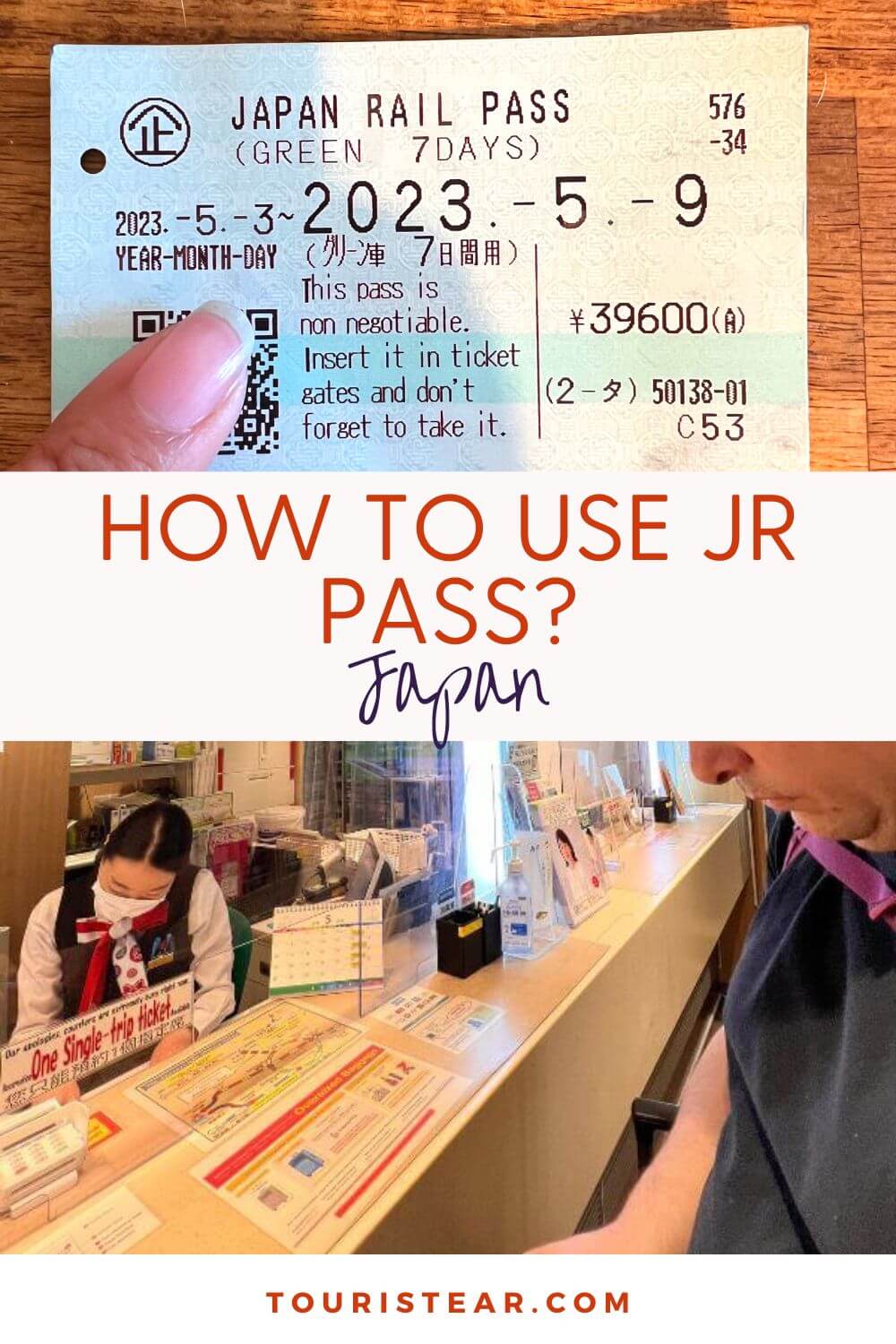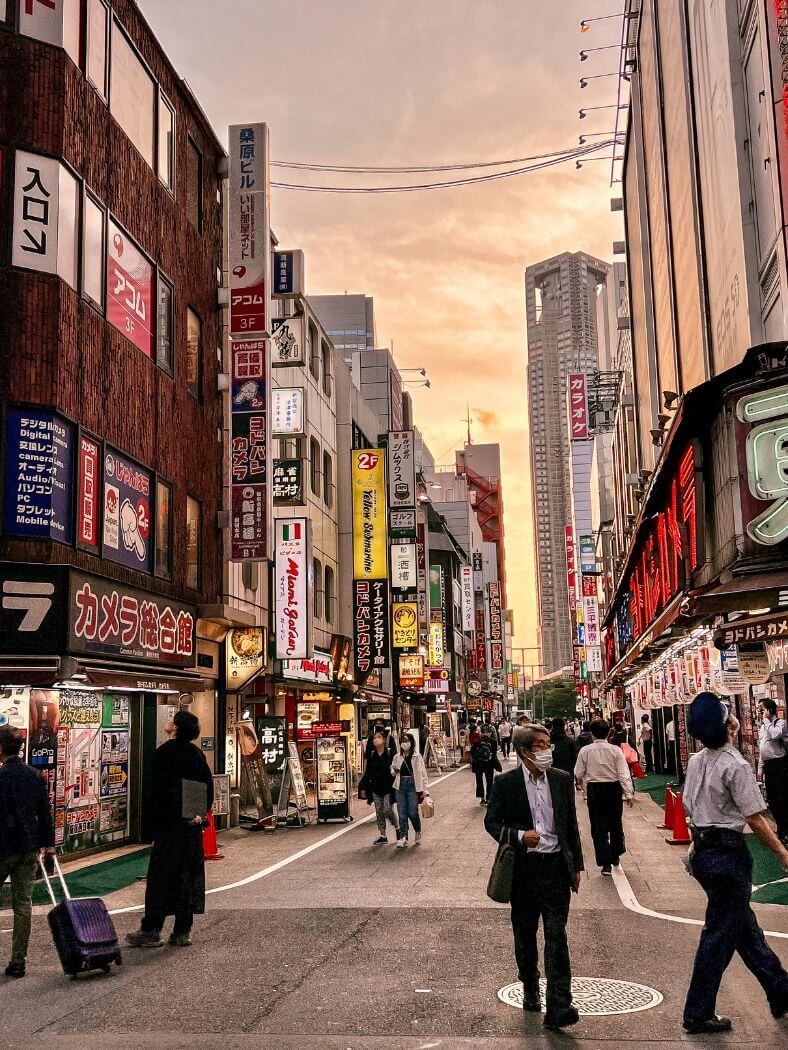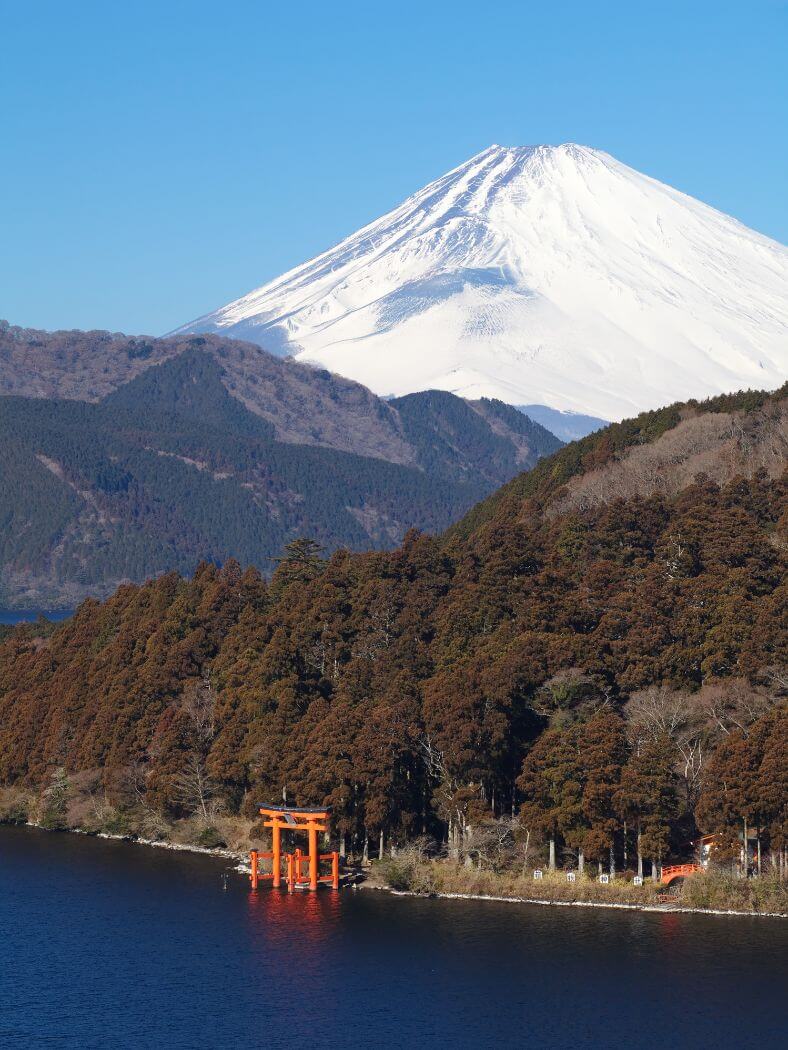50 Important Japanese Travel Phrases for Traveling to Japan
Welcome to your essential guide to Japanese phrases for traveling to Japan!
If you are planning a trip to Japan, learning some basic Japanese phrases will not only enhance your experience but will also help you connect with the local culture and people.
In this post, we will introduce you to simple but useful phrases that will make it easier for you to communicate in everyday situations, from asking for directions to shopping. Let’s get started!
Basic Phrases in Japanese
Greetings and basic phrases in Japanese
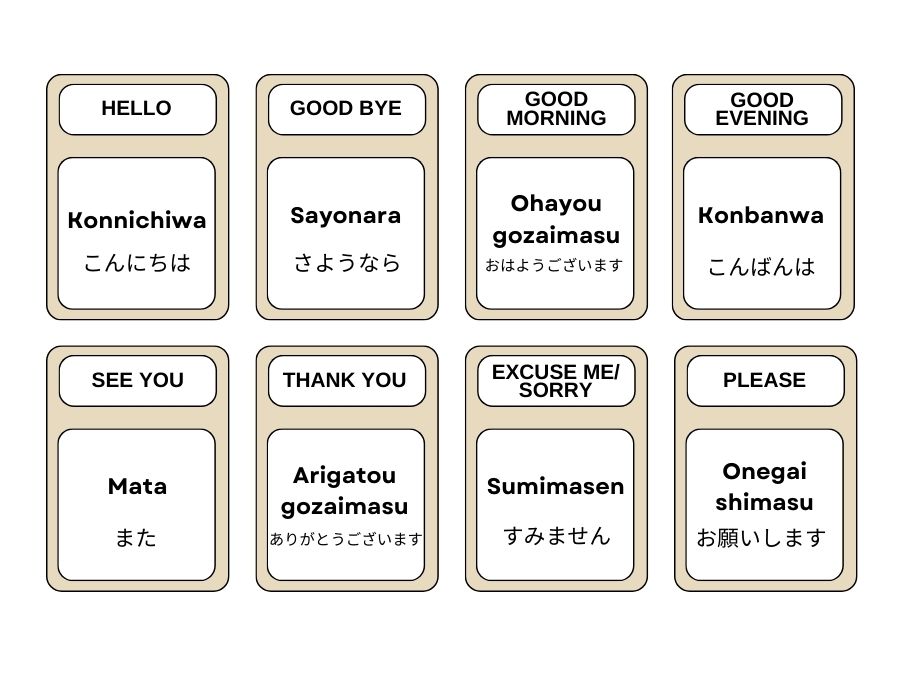
- Hello: Konnichiwa (こんにちは)
- Goodbye: Sayonara
- Good morning: Ohayou gozaimasu
- Good afternoon/evening: Konbanwa
- See you later: Mata
- See you tomorrow: mata shita
- Thank you politely: Arigatou gozaimasu (ありがとうございます). .
- Excuse me/Sorry: すみません (Sumimasen). It is used both to apologize; for example, if you bump into someone while walking, you say sumimasen; it is also used to call the waiter (as excuse me.
- Sorry: Gomenasai (ごめんなさい)
- Please: onegai shimasu (お願いします)
- You are welcome: Doo itashimashite.
- Nice to meet you: Hajimemashite (初めまして)
- I am Veronica: Veronica desu
How to say yes or no
Yes: hai! .
No: iie (you must extend the i and pronounce both).
Common Questions
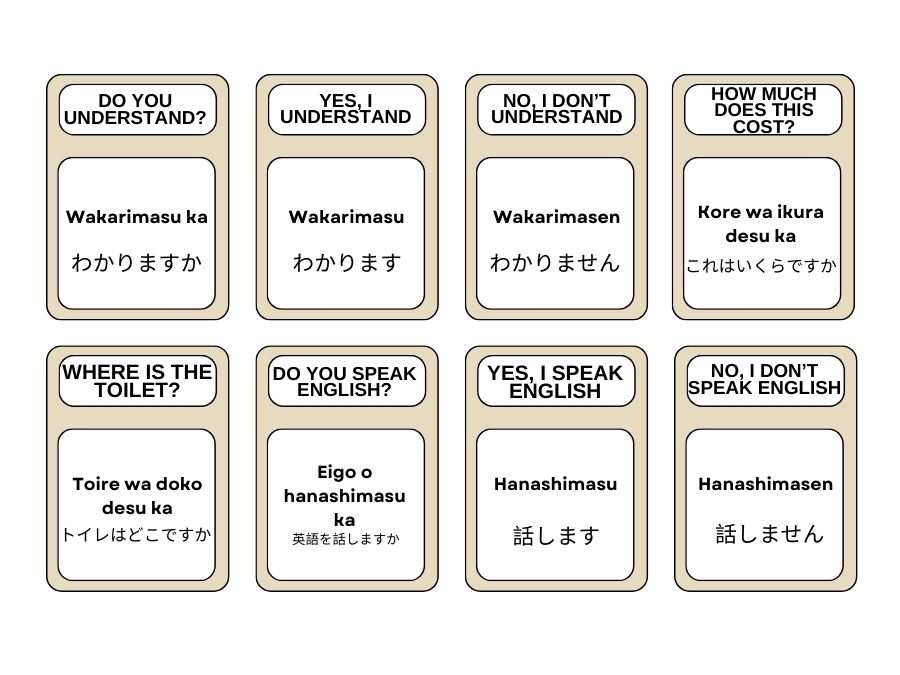
- Do you understand?: Wakarimasu ka (わかりますか)
- I understand: Wakarimasu (わかります)
- I don’t understand: Wakarimasen (わかりません)
- How much does this cost?: Kore wa ikura desu ka (これはいくらですか)
- Where is the bathroom?: Toire wa doko desu ka (トイレはどこですか)
- Do you speak English?: Eigo o hanasemasu ka (英語を話せますか)
- Yes, I speak English: Hanashimasu (話します)
- No, I don’t speak: Hanashimasen (話しません).
- I don’t understand Japanese: Nihongo ga wakarimasen.
More vocabulary
- How cute: Kawaii
- Yummy: Oishii!
- Cheers: Kanpai!
- Wait a minute: Chotto matte kudasai!
Address and Location Questions
When visiting Japan, needing help with directions and finding locations is natural. Here are some key phrases to ask for directions and locations:

- Where is this?: doko desu ka (どこですか)
- Where is the bathroom? otearai wa doko desu ka, or toire wa doko desu ka (トイレはどこですか)
- Please go straight: massugu itte kudasai (まっすぐ行ってください )
- Please turn left: hidari ni magatte kudasai (左に曲がってください )
- Please turn right: migi ni magatte kudasai (右に曲がっってください )
- Please say it again: mou ichido itte kudasai (もう一度言っってください )
山手 (yamanote) – A major train line in Tokyo, often used as a landmark for directions.
While using these phrases, keep a map handy to understand better the directions the locals give. By learning these essential Japanese phrases, you will be better equipped to ask questions and communicate effectively during your trip to Japan.
Basic Japanese numbers

- One: Ichi: 一
- Two: NI: 二
- Three: San: 三
- Four: Shi/Yon: 四
- Five: Go: 五
- Six: Roku: 六
- Seven: Shichi/Nana: 七
- Eight: Hachi: 八
- Nine: Kyu/Ku: 九
- Ten: Juu: 十
- Twenty: Nijuu: 二十
- Thirty: Sanjū: 三十
- Forty: Yonjū/Shijū: 四十
- Fifty: Gojū: 五十
- Sixty: Rokujū: 六十
- Seventy: Shichijū/Nanajū: 七十
- Ochenta: Hachijū: 八十
- Ninety: Kyūjū/Kujū: 九十
- Hundred: Hyaku: 百
These numbers are fundamental in Japanese and are used to construct other larger numbers. For example, 21 would be “二十一” (nijū ichi), literally “twenty-one”.
In the case of the number of persons, there are exceptions for one person and two persons.
- One person: Hitori
- Two people: Futari
If someone asks you how many people are, for example in a restaurant (何人ですか? (Nan-nin desu ka?))
- You can answer hitori desu, and it means 1 person.
- If you are two: futari desu
- If three: san nin desu (3 people)
- If there are four: yon nin desu (4 people)
At the restaurant
Restaurant reservations:
I would like to make a reservation at a restaurant: Resutoran o yoyaku shitai desu (レストランを予約したいです). You can ask the hotel reception to make the reservation for you.
Ask if there is availability: do you have a table for two for tonight: Konya, futari-yō no seki wa arimasu ka (今夜、二人用の席はありますか)
Specify time: I would like to book for 7: Shichi-ji ni yoyaku shitai desu (7時に予約したいです).
Arriving at the Restaurant: Confirm a reservation. I am Yamada, I have a reservation: Yoyaku or shita Yamada desu. (予約をした山田です)
If you don’t have a reservation: Do you have tables available: Seki wa aite imasu ka (席は空いていいますか)
Ordering and Eating
Look at the menu: Please show me the menu: menyū o misete kudasai. (メニューを見せてください)
Ordering food: Once you have decided what to order, you can say “Chuumon wo onegaishimasu” (注文をお願いします) followed by Kore or onegaishimasu.
This, please: Kore o onegaishimasu. (これをお願いします)
Asking for recommendations: What is the recommendation: Osusume wa nan desu ka (おすすめめは何ですか).
Before starting to eat
Itadakimasu: いただきます。 It is said before eating, similar to saying “bon appetit” in French. However, its meaning goes beyond these phrases.
Meaning and Use
Gratitude for Food: “Itadakimasu” expresses gratitude for the food to be consumed. This includes appreciation not only for the food itself but also for the effort and resources needed to prepare it.
Respect for Nature: In Japanese culture, there is a strong sense of respect for nature and all it has to offer. Saying “itadakimasu” acknowledges and thanks all life forms and natural elements that contribute to the creation of food.
Cultural Awareness: It is an expression of the harmonious relationship between humans and nature, a concept deeply rooted in many Japanese practices and traditions.
Everyday Use: Commonly said at home before meals, in restaurants, and at gatherings where food is shared.
During Lunch
- Water, please: Mizu o kudasai. (水をください)
- Tea, please: Ocha o kudasai.(お茶をください)
- Beer, please: Bīru o kudasai.(ビールをください)
Food Preferences and Requests
When ordering food, you may need to express your preferences or make specific requests. Here are some phrases to help you do just that:
To ask if a particular type of alcohol is available, e.g. sake, say, “Osake wa arimasu ka?” (お酒はありますか?).
If you want your dish to be prepared in a specific way, such as making it a little spicier, say, “Mou sukoshi karakushite kudasai” (もう少し辛くしてください).
After Eating
Thank for food: Gochisōsama deshita (ごちそうささまでした). Thank you for the food, it is said after eating.
Ask for the account
Account, please: Okanjō onegaishimasu (お会計お願いします)
To ask if they accept credit cards, you can use: “Kurejitto kaado de haraemasu ka” (クレジットカードで払えますか).
Useful Vocabulary
- Restaurant: Resutoran (レストラン)
- Reserve: Yoyaku (予約)
- Seat/Table: Seki (席)
- Menu: Menyū (メニュー)
- Please (when you ask for something): Onegaishimasu (お願いします).
- Account (in a restaurant): Okanjō (お会計).
- Mizu: water
- Green tea: Ocha
- Coffee: coohii
- Coffee with milk: kafe ore
- Black coffee: burakku koohii
- Juice: juusu
Common questions in the restaurant
- How much does this cost?: Kore wa ikura desu ka? ( これはいくらですか)
- Where is the bathroom?: Toire wa doko desu ka? (トイレはどこですか)
The Lodging
Check-in: I would like to check-in: Chekku-in or onegaishimasu. (チェックインをお願いします).
Say How Many People Are:
- We are two people: Futari desu (二人です)
- I made a reservation for one person: yoyaku shimashita’s Hitori (一人で予約しました).
Asking for Room: What is my room number: Heya bangō wa nan-ban desu ka (部屋番号は何番ですか).
Request Wifi Information: What is the Wi-Fi password: Wi-Fi no pasuwādo wa nan desu ka (Wi-Fiのパスワードは何ですか).
Ask for Help or Information: Excuse me, [tu pregunta]: Sumimasen, [tu pregunta] (すみません、[tu pregunta])
Check-Out: I would like to check-out: Chekku-auto or onegaishimasu. (チェックアウトをお願いします)
Ask Check-Out Time: What time is check-out: Chekku-auto no jikan wa nan-ji desu ka? (チェックアウトの時間は何時ですか)
Thank you when leaving: Thank you for everything (said as a token of appreciation for the attention received): Osewa ni narimashita. (お世話になりました)
Getting around the city
Ordering General information
- (Place) wa doko desu ka: general phrase to ask where something is; it can be a destination, a station, or even the toilet.
- (Place) e ikitai no desu ga: I would like to go to …
- Where is the subway station? Chikatetsu no eki wa doko desu ka. (地下鉄の駅はどこですか)
- Where is the train station?: Densha no eki wa doko desu ka (電車の駅はどこですか)
- Ask Hotel Directions: Where is the hotel [Nombre del Hotel]?: Hoteru [Nombre del Hotel] wa doko desu ka: ホテル [Nombre del Hotel] はどこですか
- Ask How to Get to a Tourist Site: ([Nombre del Sitio Turístico] wa doko desu ka. [Nombre del Sitio Turístico] はどここですか)
- Ask for the Bus Stop: Where is the bus stop? Basu tei wa doko desu ka. (バス停はどここですか)
- Ask if a Train/Bus goes to a Specific Destination: Does this train/bus go to [Destino]? Kono densha/basu wa [Destino] ni ikimasu ka (この電車/バスは[Destino]に行きますか)
- Ask to be advised where to get off: I would like to get off at [Destino], could you please let me know. [Destino] de oritai no desu ga, oshiete itadakemasu ka. ([Destino]で降りたいのですすが、教えていただけますか)
- Confirm Address: Is this going to [Destino]?: Kore wa [Destino] e mukatte imasu ka. (これは[Destino]へ向かっていますか)
Other interesting phrases to learn or print
- Where is this place?: Koko wa doko desu desu ka? (ここはどこですか)
- Please look at this map: Kono chizu wo mite kudasai (この地図を見てください)
- How can I get to this place?: Koko ni iku ni wa dou sureba ii desu ka? (ここに行くにはどうすればいいですか)
- How can I get to this location?: Kono basho ni wa douyatte ikemasu ka? (この場所にはどうやって行けますか)
- How far away is it?: Dono kurai tooi desu ka? (どのくらい遠いですか)
- Where can I look for information about transportation in this area?: Kono chiiki no koutsuujouhou wa doko de shiraberaremasu ka? (この地域の交通情報はどこで調べられますか)
In case you need any clarification or additional information:
- Sorry, can you tell me one more time: Moushiwake arimasen ga, mou ichido oshiete itadakemasu ka? (申し訳ありませんが、もう一度教えていただけますか?)
- Does this bus go to ….? Kono basu wa (destination) yuki desu ka? (このバスは○○行きですか?)
- Where can I take the bus? Doko de basu ni noremasu ka? (どこでバスに乗れますか?)
- Can I get to the station… with this? Kore de …-eki ni ikemasu ka? (これで….駅に行けますか?)
- I plan to get off at the next station. Tsugi no eki de oriru yotei desu (次の駅で降りる予定です) –
- Is the track northbound or southbound? Nanboku-me desu ka? (南北目ですか?)
- Where is the station? Eki wa dochira desu ka? (駅はどちらですか?)
- Which platform is this train on? Kono densha wa nanbansen desu ka? (この電車は何番線ですか?)
Directions by Taxi
Taking a cab in Japan is convenient and comfortable. To ensure clear communication with your driver, learn these phrases:
- I want to take a cab. Takushii wo hirotai no desu ga (タクシーを拾いたいのですが) –
- Please go to “destination”: “destination” ni itte kudasai (…に行ってください).
Useful vocabulary
- Input: iriguchi (入口)
- Exit: deguchi (出口)
- Subway: chikatetsu (地下鉄)
- Subway stop/subway station: chikatetsu no eki (地下鉄の駅)
- Airport: kuukoo (空港)
- Cab: takushii (タクシー)
- Bus: basu (バス)
- Map: chizu (地図)
- Itinerary: Ryotei (旅程)
Shopping in Japan
Money
- Japanese banknotes are 1000 (千円: sen-en), 5000 (五千円: go sen en and 10000 (一万円: ichi man en) yen.
- Yen in Japanese is said en and this is its kanji: 円
- Coins: 1 yen, 5 yen, 10 yen, 50 yen, 100 yen and 500 yen. They are very useful, especially in villages, temples, markets, etc.
- Ask where there is an ATM: ATM wa doko ni arimasu ka, o
- There is an ATM nearby: Chikaku ni ATM wa arimasuka.
- ATM is pronounced almost like in English but with the u at the end.
In a store
Order a Specific Size: Do you have this clothing in size [M Talla]?: Kono fuku no [M Talla] saizu wa arimasu ka? (この服の[M Talla]サイズはありますか)
Ask for a Specific Color: Do you have this in this color: Kono iro no mono wa arimasu ka? (この色のものはありますか)
How much does it cost: Kore wa ikura desu ka (これはいくらですか).
Asking to Try Something on: Can I try this on: Kore o shichaku shite mo ii desu ka? (これを試着してもいいですか)
Ask for Local Souvenirs: Do you have local souvenirs: Jimoto no omiyage wa arimasu ka? (地元のお土産はありますか)
Asking for a Bag: Do I need a bag: Fukuro wa irimasu ka? (袋はいりますか)
Methods of Payment: Can I use a credit card: Kurejittokādo wa tsukaemasu ka? (クレジットカードは使えますか)
If You Need Help: Excuse me, could you help me: Sumimasen, tetsudatte itadakemasu ka? (すみません、手伝っていただけますか)
Vocabulary: Colors in Japanese
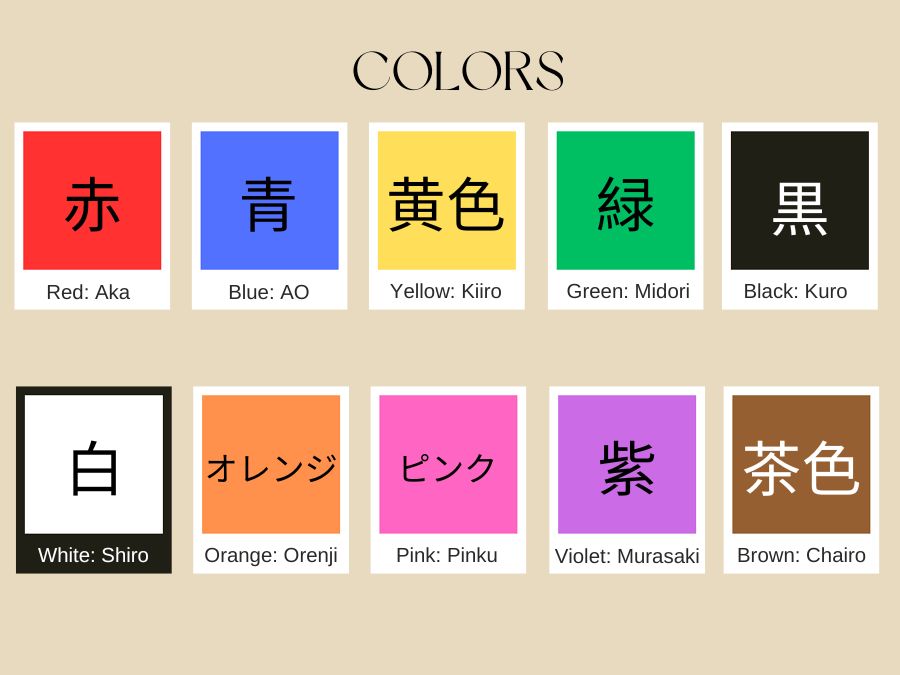
- Red: 赤 (Aka)
- Blue: 青 (Ao)
- Yellow: 黄色 (Kiiro)
- Green: 緑 (Midori)
- Black: 黒 (Kuro)
- White: 白 (Shiro)
- Orange: オレンジ (Orenji)
- Pink: ピンク (Pinku)
- Purple: 紫 (Murasaki)
- Brown: 茶色 (Chairo)
Ask for help
- Can you help me, please? Tasukete itadakemasu ka. (助けていただけますか)
- I’m lost: Michi ni mayoimashita (道に迷いました)
- Can you take me or accompany me to… (Place) made onegaishimasu.
- Do you speak English? Eigo o hanasemasu ka (英語を話せますか)
- . .
- Where is the bathroom?: Toire wa doko desu ka (トイレはどこですか)
- I need a doctor: Isha ga hitsuyō desu (医者が必要です)
- Could you show me on the map? Chizu de oshiete itadakemasu ka (地図で教えていただけますか)
- How did I get to [destino]? [Destino] e wa dō ikeba ii desu ka ([Destino]へはどう行けばいいですか)
- I need to call the police: Keisatsu o yobu hitsuyō ga arimasu. (警察を呼ぶ必要があります)
- Can you call me a cab? Takushī o yonde itadakemasu ka. (タクシーを呼んでいただけますか)
Etiquette
Here is a summary of etiquette and customs in Japan, which are fundamental to understanding and respecting Japanese culture:
Greetings: Japanese people usually bow their heads (bowing). Handshakes are less common and are reserved more for international situations.
Removing Shoes: It is customary to remove shoes when entering houses and certain places such as temples and ryokans (traditional inns). Slippers are often available for indoor use.
Punctuality: Punctuality is very important in Japan. Being late is considered disrespectful.
Behavior in Public Places: People are expected to be calm and respectful in public places. Talking loudly, especially on public transportation, is considered impolite.
Do not eat or drink while walking, as you may stain another person. Keep in mind that there are a lot of people.
Do not stand suddenly in the middle of the sidewalk, since there are so many people, it is better to stand on a side where you do not disturb the people walking.
Handling Chopsticks: Never stick chopsticks in your food, especially rice, as it is associated with funeral rituals. Also, do not pass food from chopsticks to chopsticks.
Gifts: Gift-giving is an important part of Japanese culture, especially when visiting someone in their home. Gifts are usually carefully wrapped and given and received with both hands.
Money: When paying in stores and restaurants, use the small tray provided to place money. Handing the money directly into the hand is not usual.
Meals: It is customary to say “itadakimasu” before eating and “gochisousama deshita” after eating. This shows respect and appreciation for the food.
Business Cards: In professional environments, the exchange of business cards is a ritual. Receive and hand out business cards with both hands, and take a moment to read the card before putting it away.
Photographs: Ask permission before photographing people, especially geisha or maiko in places like Kyoto.
This etiquette reflects the importance of respect, harmony and consideration for others in Japanese society. Knowing and following these rules can help make your experience in Japan smoother and more respectful.
Language Learning Tips
To begin learning Japanese for travel, start with some basic greetings such as “konnichiwa” (こんにちは; hello) and “ohayou gozaimasu” (おはようございます; good morning).
In addition to greetings, be sure to learn important phrases such as “sayounara” (さようなら; goodbye), “arigatou gozaimasu” (ありがとう; thank you), and “sumimasen” (すみません; excuse me).
Keep these tips in mind as you learn:
Practice regularly: Spend a few minutes every day reviewing and practicing your Japanese phrases to retain them in your memory.
Learn phonetically: Write down phrases in a way that helps you remember the pronunciation. Fortunately, for those of us who speak Spanish or Italian, pronunciation is not a problem, you just need to know some basic rules.
Carry a phrasebook or have a language app handy: Use them as a reference during your trip to look up phrases or practice while on the go.
Make flashcards: Write the Japanese phrase on one side and the English translation on the other.
Cultural Immersion: Try to immerse yourself in Japanese culture through movies, music, television programs and books in Japanese. This not only improves your understanding of the language, but also familiarizes you with Japanese culture and customs.
Interactive Learning Applications: Use applications that offer interactive and playful learning, such as Duolingo, Rosetta Stone or Babbel. These applications can make learning more engaging and fun.
Use Translation Tools and Dictionaries: Tools such as Google Translate or electronic dictionaries can be useful for quick translations and for helping users better understand new words and phrases.
Plan Your Trip to Japan
- How to plan a trip to Japan
- Itinerary of 11 full days in Japan
- How to use JRPass
- The best airport to get to Tokyo
- What to see in Tokyo
- What to see in Hakone
- What to see in Osaka
Last Updated on 29 January, 2024 by Veronica
